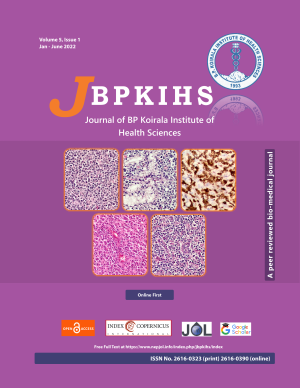Spectrum of Lymphoma: A Five Years’ Experience of Tertiary Care Centre in Eastern Nepal
DOI:
https://doi.org/10.3126/jbpkihs.v5i1.42723Keywords:
Hodgkin's lymphoma, Non Hodgkin’s Lymphoma, WHO classification systemAbstract
Background: Immunophenotyping and improvement in classification system of lymphoma gains better epidemiological comparison in incidence and pattern. We aimed to study the spectrum and clinic-epidemiological profile of lymphoma and categorize the type and subtype of lymphoma according to 2008 WHO classification system.
Methods: This hospital-based retrospective, cross-sectional study included all cases of lymphoma diagnosed in a 5-year period from January 2012 to December 2016. Demographic indices and the clinical details provided by various departments were noted in a proforma and the type and subtype of lymphoma were categorized according to 2008 WHO classification system.
Results: There were a total of 47 cases of lymphoma, of which only 68% could be categorized. B cell lineage lymphomas comprised of 61.7% cases and the rest (6.3%) belonged to T cell lineage. Out of these, diffuse large B cell lymphoma (DLBCL) (21.2.% of total lymphoma) was found to be the commonest type of Non-Hodgkin’s lymphoma (NHL) followed by classical type of Hodgkin’s lymphoma (HL) (12.7% of total lymphoma). The highest number of cases were seen in the 6th decade. The mean age was 48.22 years for NHL and 42.60 years for HL. Male (70.2%) outnumbered female.
Conclusion: Categorization of lymphoma according to the 2008 WHO classification system was achievable in 68% of cases with the aid of various immunophenotyping panels. B cell lineage lymphoma comprised of the majority of cases and DLBCL was seen to be the commonest type of lymphoma. Ancillary technique plays an important role in designating the spectrum of lymphoma.
Downloads
Downloads
Published
How to Cite
Issue
Section
License
Copyright (c) 2022 Journal of BP Koirala Institute of Health Sciences

This work is licensed under a Creative Commons Attribution-NonCommercial-NoDerivatives 4.0 International License.
This license enables reusers to copy and distribute the material in any medium or format in unadapted form only, for noncommercial purposes only, and only so long as attribution is given to the creator.




